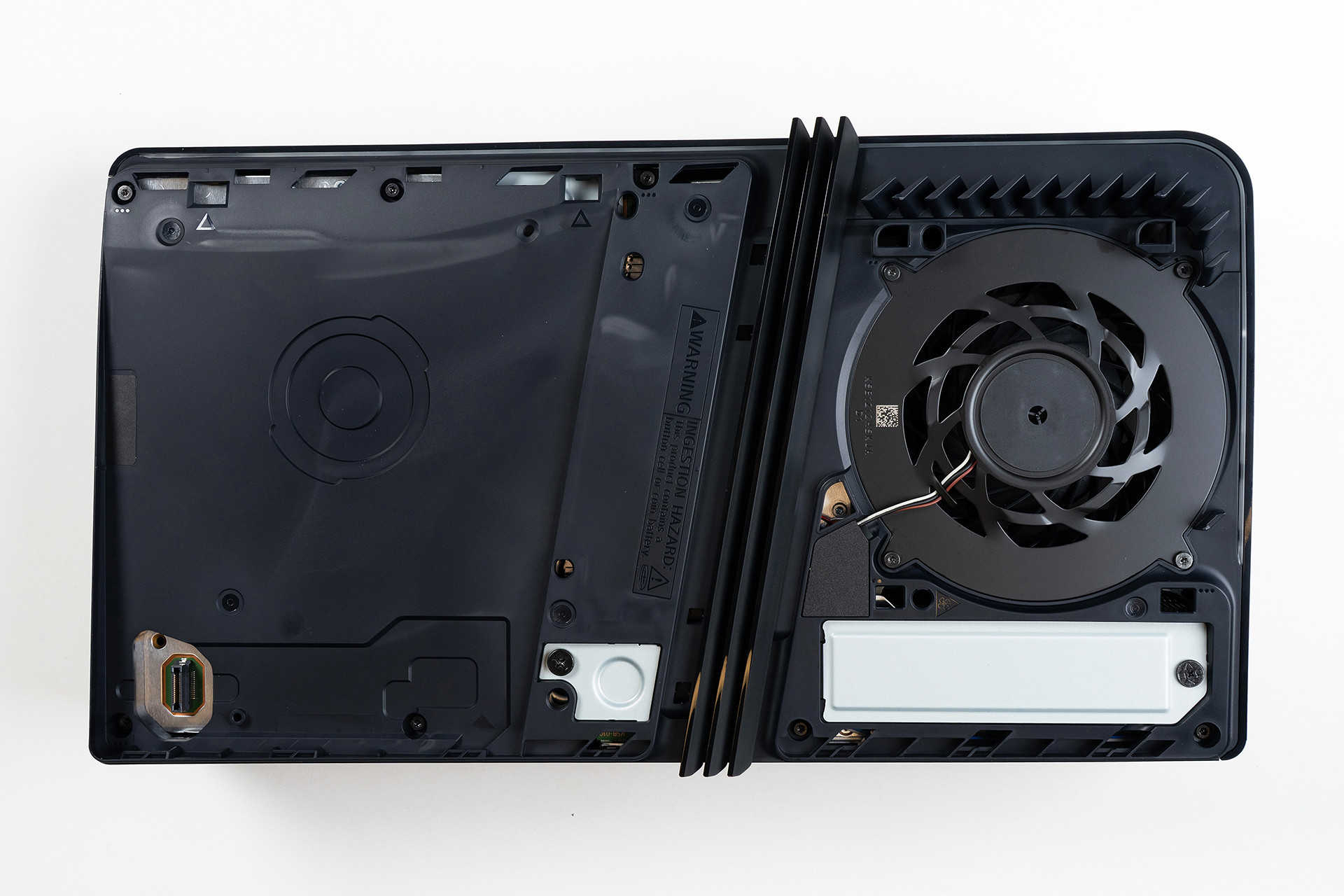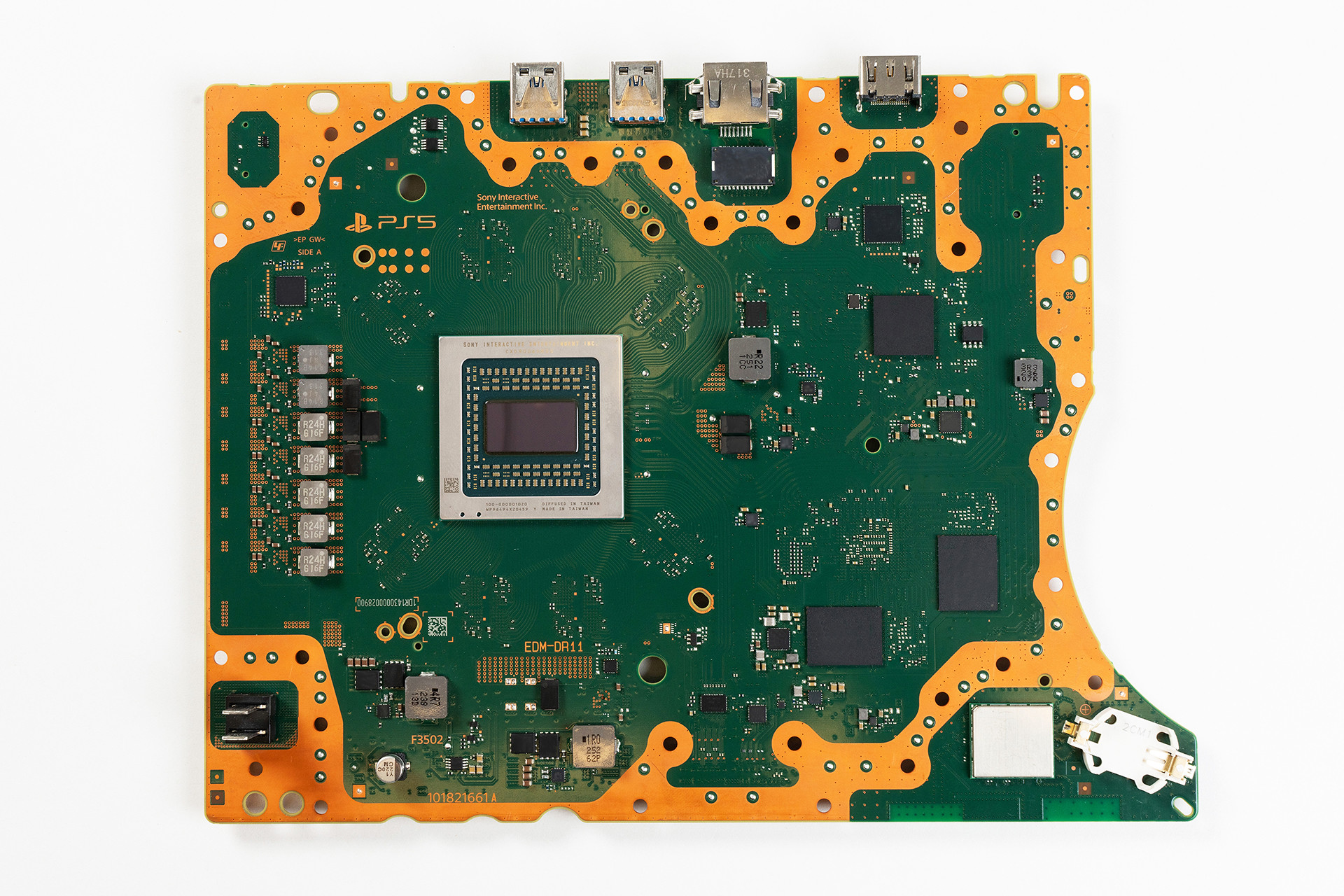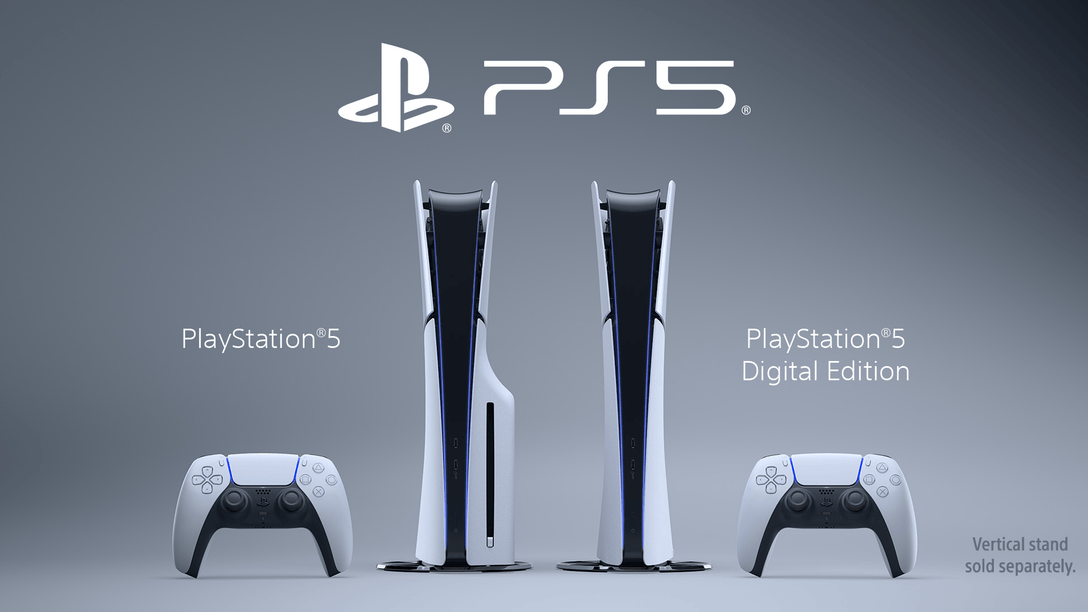
A deep-dive into the cutting-edge technology and innovation packed into the PS5 Pro.
PlayStation 5 Pro console — the most innovative PlayStation console to date — elevates gaming experiences to the next level with features like upgraded GPU, advanced ray tracing, and PlayStation Spectral Super Resolution (PSSR) – an AI-driven upscaling that delivers super sharp image clarity with high framerate gameplay. Today we’re providing a closer look at the console’s internal architecture, as Sony Interactive Entertainment engineers Shinya Tsuchida, PS5 Pro Mechanical Design Lead and Shinya Hiromitsu, PS5 Pro Electrical Design Lead, provide a deep-dive into the console’s innovative technology and design philosophy.
*In this article, we refer to the PlayStation 5 model released in 2020 as the “original PS5,” the PS5 released in 2023 as the “current PS5,” and the PS5 Pro released in 2024 as the “PS5 Pro.”
*Do not try this at home. Risk of fires, and exposure to electric shock or other injuries. Disassembling your console will invalidate your manufacturer’s guarantee.


Name: Shinya Tsuchida (PS5 Pro Mechanical Design Lead) (Right of photo)
Name: Shinya Hiromitsu (PS5 Pro Electrical Design Lead) (Left of photo)
An exterior design featuring three distinct horizontal lines
Tsuchida: Before we begin the teardown, I’ll start by going over the PS5 Pro’s exterior design. PS5 Pro is a high performing console, so it requires more air to cool it down. The distinctive three slits are new airflow paths that were not present in the original PS5, or the current PS5. This design was conceived through extensive discussions between the engineers and designers, and we refer to them as ‘blades’ within the engineering team. The slits enhance airflow while also acting as a design element.

Exterior design comparison between the original PS5 (left), the current PS5 (center) and PS5 Pro (right). PS5 Pro is slightly smaller in size compared to the original PS5.

While the look of the PS5 Pro is consistent with the rest of the PS5 family of products, it features three distinct blades that contribute to improved ventilation.
‘Louvers’ between the main unit and cover help to make the console quieter
Tsuchida: Inside the PS5 Pro, there is a structure called a “louver” that sits between the main unit and cover, which looks like a series of slats or fins. While it’s part of the design, it also prevents some of the fan noise from escaping the console towards the front direction. Since most users will play games while facing the front of the console, we intentionally designed the system to make it harder for players to hear the fan.
Rear changes for more efficient airflow
Tsuchida: Next, let’s take a look at the back of the console. We place importance on the types and arrangement of the input/output ports. Since the power button is something everyone uses, there’s been a shared understanding among our successive design teams that it’s better to have it positioned at the bottom rather than the top when the console is placed vertically. On the other hand, the positions of the HDMI, LAN, and USB ports are placed slightly higher compared to the current PS5. This is because the PS5 Pro’s mainboard features a high-density circuit design, and the port placement has been adjusted to accommodate the change.
The vent (exhaust vent) surface is also larger compared to other PS5 models, and air is taken in and exhausted from the rear and bottom surfaces. The size of the intake and exhaust vents is important for better ventilation, and we knew from preliminary research that they needed to be larger than the current PS5, so we decided on the size after discussing with the design team.
The teardown begins
Tsuchida: Let’s start the teardown. On the top side, just like in previous PS5 models, a dust catcher is provided for cleaning purposes. On the bottom side, there is an M.2 SSD slot, a disc drive connector, and a hatch for inserting a coin cell battery.


Tsuchida:The screw holding the battery is intentionally designed to stay attached to the battery cover, preventing it from being lost or accidentally swallowed—a thoughtful safety feature.

A new fan that quietly increases air flow
Tsuchida: After disconnecting the fan cables, we can now remove the blades and inner shell. I’m also removing the fan itself. Like I mentioned earlier, the PS5 Pro requires more air for cooling, and the fan is designed to generate airflow more efficiently. The overall size of the fan is larger than the current PS5 model’s as well.


Comparison of the PS5 Pro’s fan (left) and the current PS5 model’s fan (right)
Tsuchida: The two fans have the same number of blades, but our teams re-designed the blade shape for further optimization. If you look closely, you can see that there are even smaller blades in between each blade. Generally speaking, if a fan has good airflow efficiency, it’s considered better and higher performing. However, we designed our fans to be more than that — we wanted our fans to produce more air “quietly.” It may be generally acceptable for fans to be louder as long as it’s creating more airflow, but this isn’t the case for game consoles as it can disrupt the gameplay experience. I think this specific design philosophy is unique to PlayStation consoles.

Screws to suppress electromagnetic noise
Tsuchida: Now let’s remove the metal shield located further inside the cabinet. The shield is secured to the mainboard with a large number of screws—and there’s a reason for that. Most components on the mainboard generate electromagnetic noise. Since this noise can interfere with nearby electronic devices, such as smartphones, and potentially disrupt their operation, we must suppress the amount of electromagnetic emissions to be kept below a certain threshold. The screws securing the shield are strategically placed to reduce electromagnetic interference.

An evolved motherboard that achieves heightened gameplay
Tsuchida: Once we remove the top and bottom shields, you’ll reach the PS5 Pro’s motherboard. One characteristic of PS5 consoles is that they leverage liquid metal with excellent thermal conductivity for the TIM (Thermal Interface Material) of its main processor. Before we get into details, I’ll provide some explanation using a board before the liquid metal is applied.
PS5 Pro’s motherboard is larger than that of the current PS5. The current PS5 model’s board is curved where the fan sits, but the PS5 Pro has a larger board due to the increased number of circuits required to achieve PS5 Pro’s enhanced performance, which changed the position of the fan. As I mentioned earlier, you’ll notice the location of the input and output ports on the back of the unit is different as well.

The top side of PS5 Pro’s motherboard.

The top side of current PS5 model’s motherboard.
Hiromitsu: The SoC (System-on-a-Chip) is the large chip you see on the center of the board. This chip handles the rendering of high-resolution, high-frame-rate graphics, including the PlayStation Spectral Super Resolution (PSSR), which uses AI-enhanced resolution for ultra-high-definition gameplay. To maximize the performance of the SoC, the power delivery lines have also been enhanced compared to the current PS5.
In addition, PS5 Pro’s board has more layers compared to the current PS5. If you look closely at the surface of the current PS5 model’s motherboard, you can see the traces that connect the SoC and RAM. However, on the PS5 Pro’s board, the traces are barely visible on the surface. This is because the PS5 Pro’s motherboard was designed with additional internal layers, which allows signal traces to be routed more efficiently through the inner layers achieving even faster memory performance.
Now let’s compare the back side of the motherboards. The main visible difference is that the number of RAMs placed around the SoC has increased from eight to nine. All PS5 consoles up to the current PS5 were equipped with eight chips of high-speed GDDR6 memory, which handled high-speed rendering for games as well as low-speed processing for the rest of the OS. In the PS5 Pro, we added a ninth DDR5 memory which is dedicated to the slower processing, while the remaining eight GDDR6 memories handle all the high-speed rendering required for gameplay. The GDDR6 RAMs themselves have also been improved and are faster than those equipped on the previous PS5 models as well.

The back side of PS5 Pro’s motherboard. A ninth DDR5 memory chip was added to the upper right corner (circled in red in the photo), in addition to the eight GDDR6 laid out in a circle.

The back side of the current PS5 model’s motherboard.
The innovative use of liquid metal became an integral piece of technology that has been carried over to successive PS5 models.
Tsuchida: Using liquid metal as the TIM in the original PS5 was quite challenging at the time. Since liquid metal has far superior cooling capabilities compared to conventional TIMs, we adopted it after conducting various tests to ensure its safety.
We spent quite some time conducting research on insulation when we were designing the original PS5. The basic structure remains the same in the PS5 Pro, but we made some improvements by adding fine grooves where the liquid metal is applied, so that the cooling effect is more stable. When we were doing research for the original PS5, we anticipated that semiconductors would continue to advance and become much denser, so we believed liquid metal technology would become crucial. It turns out we were right, and it was integral when designing the PS5 Pro.


For more stable cooling, grooves have been added where the liquid metal is applied.
Developing a larger power supply unit with higher output
Hiromitsu: This is the power supply unit. The PS5 Pro outputs about 48W more compared to the current PS5 and is also larger in size. The curved power supply units are meticulously designed for each PS5 iteration, so that it fits perfectly into the chassis. Fun fact, the unit has “Sony Interactive Entertainment” engraved near the bottom, so it’s easy to tell which side is the top or bottom. This obviously isn’t immediately visible to the consumer, but it is a small detail that indicates the correct orientation when the console is placed vertically.

A perfectly placed heat sink
Tsuchida:The heat pipes are made of copper. The silver components of the heat sink are made of aluminum to dissipate heat, and the rest of the gray parts are made of steel.
PS5 Pro’s heat sink has more heat pipes, as the console requires a more powerful heat sink to support its high performance. The heat pipes are located next to the SoC, and the fins that transfer heat from the heat pipes are divided into two sections. A heat sink’s cooling capabilities vary greatly depending on its placement, so we put a lot of effort into finding the perfect layout.

Adopting Wi-Fi 7 for even faster connectivity
Hiromitsu: On the top side of the mainboard, you’ll find the Wi-Fi 7 module. Wi-Fi 7 is a new standard released in 2024, and we chose to adopt it for the PS5 Pro based on its high performance and future potential.
During the development of the PS5 Pro, Wi-Fi 7 had not yet been officially released, which made the validation process quite challenging. But we were glad we were able to become early adopters for a gaming console when we got it certified in time for launch in regions that supported Wi-Fi 7.

The white section visible at the bottom right of the top side of the board is the Wi-Fi 7 module. An antenna is also located just beneath it.
And that’s a wrap! We hope you enjoyed getting an inside look at the internal architecture of the PS5 Pro. Each component works together in harmony to realize the console’s innovative features, like stunning graphics and smooth gameplay.













Comments are closed.
26 Comments
Loading More Comments